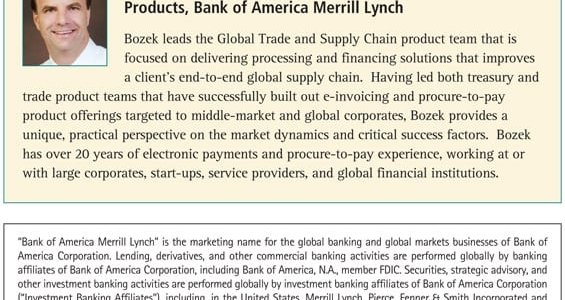by Chris Bozek, Managing Director, Head of Global Trade and Supply Chain Products, Bank of America Merrill Lynch
Gone are the days when treasury and trade were seen as separate. The move away from letters of credit in recent years has combined with a greater focus on counterparty risk and cash flow, leading more corporations to take a comprehensive approach to treasury and trade. Financial institutions and technology vendors are similarly aligning themselves to provide an integrated working capital offering – one that often features a supply chain finance component.
In the past, corporations tended to regard business-to-business invoice processing and accounts payable (AP) payment processing as a wholly separate activity from the more complex, cross-border trade finance side of the business. However, in recent years, the argument for taking an integrated approach to treasury and trade has grown stronger as a number of trends within the market have combined to make the holistic approach more attractive. Consequently, corporations, banks and technology providers are increasingly looking at ways of bringing these areas together.
The road to convergence
As open account trade continues to replace the use of letters of credit, in many companies, the gulf between treasury and trade has narrowed or closed completely. Banks have responded by building out their procure-to-pay processing, payments (cards and traditional payments), and financing business, designed for open account trading, complement traditional trade and create a clear convergence.
The aftermath of the global financial crisis has increased corporate focus on strategically managing working capital. Corporations have reassessed their own processes to find ways to free up cash and reduce their funding needs. Real-time visibility has become a must-have for treasurers and CFOs. For this to be achieved, data cannot be locked in different silos at the corporate or at the bank. Businesses are increasingly starting to integrate financial and physical supply chain data in a consolidated view to increase visibility and optimise their cash position.
Sign up for free to read the full article
Register Login with LinkedInAlready have an account?
Login
Download our Free Treasury App for mobile and tablet to read articles – no log in required.
Download Version Download Version




























